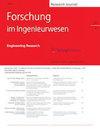在一目了为的过程中
IF 1
4区 工程技术
Q2 Engineering
Forschung Im Ingenieurwesen-Engineering Research
Pub Date : 2023-10-10
DOI:10.1007/s10010-023-00717-z
引用次数: 0
摘要
在负重力操作或风车过程中,减轻重量的策略消除了可选的二次润滑系统,从而导致润滑条件的丧失(LOL)和磨损,从而加剧了对高压和高速等齿轮部件的日益增长的需求。为了了解能够承受高速LOL的齿轮设计选项,需要对模型试验台(例如双盘钻机)进行系统的基础研究。为此,设计了双盘钻机,该钻机能够在高达80 m/s的高夹带速度和高润滑油喷射温度下进行测试。在连续润滑和LOL条件下进行了系统的研究,并从摩擦和失效时间(TOF)两方面进行了评价。混合EHL模型补充了实验矩阵,得到了更宽的温度范围,并比较了磨削方向对润滑油间隙的影响。在连续模式下,夹带速度对摩擦的影响最为显著,主要体现在从8 m/s增加到23 m/s时,在进一步增加到30 m/s时变化不大。在高夹带速度下,注入温度的影响最为显著。接触压力对TOF的影响最大。与超精加工的圆盘表面相比,跑道上的TOF大幅增加,磨损损伤骨折明显减少。本文章由计算机程序翻译,如有差异,请以英文原文为准。
Untersuchung von Reibung und Fressneigung bei Verlust der Schmierung auf einem Zweischeiben Teststand
Abstract Increasing demands on gear components such as high-pressure and high speeds are aggravated by weight saving strategies eliminating an optional secondary lubrication system during negative g operations or windmilling, which result in loss of lubrication conditions (LOL) and scuffing. In order to understand gear design options able to withstand LOL at high velocities, systematic, fundamental studies on model test-rigs, e.g. twin-disc rigs, are required. For this purpose, a twin-disc rig was designed which is able to perform test at high entrainment velocities of up to 80 m/s and high lubricant injection temperatures. Systematic studies have been carried out in continuous lubrication and LOL condition and evaluated in terms of friction and time-of failure (TOF). A mixed EHL model complemented the experimental matrix for wider range of temperatures and additionally compared the influence of the grinding direction on the lubricant gap. Entrainment velocity showed to have the most prominent influence on friction in continuous mode, mostly for the increase from 8 m/s to 23 m/s, followed by minor changes upon further increase to 30 m/s. The influence of injection temperature was mostly prominent at high entrainment velocities. Contact pressure had the strongest influence on TOF. Comparisons with superfinished disc surfaces exhibited a high increase in TOF and significantly less scuffing damage fractures on the runway.
求助全文
通过发布文献求助,成功后即可免费获取论文全文。
去求助
来源期刊
CiteScore
2.20
自引率
9.10%
发文量
33
审稿时长
>12 weeks
期刊介绍:
This journal is aimed at those who require an interdisciplinary overview of current research in fundamental areas of engineering science as well as outstanding contributions in their own field. It intends to encourage an exchange of ideas between the areas of research and development. Submissions are subject to regular peer review by independent experts. Mainly contributions in German from all disciplines of engineering and technology will be considered for evaluation and publication.

 求助内容:
求助内容: 应助结果提醒方式:
应助结果提醒方式:


